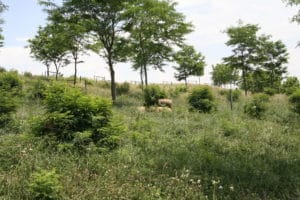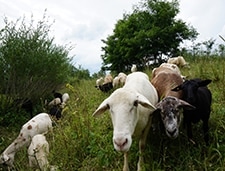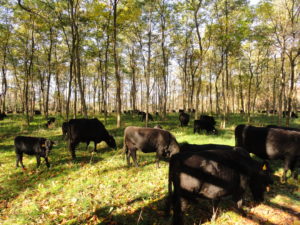Six Key Principles for a Successful Silvopasture
Within the practice of agroforestry, or mixing trees with agricultural production, the concept of silvopasture has some of the broadest appeal. Many farms already work with livestock, and making good use of forested land for multiple yields is highly beneficial to the farmer.
Whether you choose to graze sheep in a Christmas tree farm, move cows through a walnut plantation, or graze chickens though an apple orchard, several key principles apply. In reading about silvopasture, you will see again and again that that system is not just “throwing animals” into the woods, or planting some trees in the pasture. There must be thought, planning, and intention as the farmer designs the system. This article outlines six of the key considerations for getting started in Silvopasture.
- Silvopasture can be established in existing woodlands, or trees can be brought into pasture
One of the nice aspects to silvopasture is that one can establish a system on almost any type of land. Of course, establishing it in existing forest is a very different process in many ways than bringing the trees into open pasture. The only land types we might consider avoiding silvopasture are sensitive areas such as wetlands and healthy, maturing hardwood forests that might be best left to their own process of succession.
If starting with forest, the farmer needs to change the ecology (i.e. thin a bunch of trees) to support the establishment of forages, which include grasses, legumes, forbs, and

Sheep graze a Honey Locust Silvopasture at the Virginia Tech research farm. Photo courtesy of Gabriel Pent.
shrubs and trees meant as fodder for livestock. Trees could also produce fruits and nuts for foraging, such as chestnuts or persimmons, which animals could harvest once they fall to the ground.
In the pasture, the goal is to add trees without blocking too much light from hitting the ground, which could suppress forage growth. Trees can be planted in rows, clusters, or evenly spaced in an orchard-like planting. Fast growing species such as locust, alder, willow, and poplar offer an advantage because they can quickly grow above browse height, which allows for faster integration with grazing management.
In any case, a balance has to be struck so that all parts of the system are optimized. Remarkably, research has shown that some pasture grasses actually perform better under partial shade. Less surprising is that animals also do better, benefitting from the cooling effects of shade, especially in the hot summer months.
- Animals are matched to land type and stage of succession
It’s critically important from the outset that the appropriate animal is chosen for a given site in order to reduce the potential of inflicting damage to the landscape. Animals are incredible at what they do, but it cannot be overstated that they have just as much potential to do good as they do harm. Some of the potential risks include:
Cows: excessive stocking/duration with their weight could damage soil, tree roots, and cause erosion, also prone to easily destroy young trees.
Pigs: could root and trample desired vegetation and make a moonscape of your woods or pasture in a very short about of time.
Sheep & Goats: depending on forage type could overgraze the landscape and/or strip the bark off young trees, killing them.
Poultry: could scratch or root down to bare soil and damage roots and plantings.
Animals can do a lot of good, or a lot of harm. You can see from the above list that most of the problems can be avoided by doing proper assessment of the land and engaging with the animals to ensure they are moved before doing harm.
In addition to choosing the right type of animal for the system, careful selection of the specific breed is an essential task. Some breeds are able to utilize a wider range of forage and conditions, whereas others are not as willing to be as flexible. Often, farmers can have success “training” animals to be better browsers on a range of forage, if they are not accustomed to seeking it out.

Sheep at the authors farm grazing a paddock with planted Willow and Black Locust. Photo by Steve Gabriel
- Animals are always on a rotation
This principle is implied above, and proper rotation of animals has been shown to have a myriad of benefits to a farm. Moving animals allows for a given paddock to rest and recover, which is critical to maximizing forage quantity and quality. Moving animals is good for them, as well, as they have reduced exposure to disease and are receiving the highest quality food possible.
This aspect of silvopasture is NON-NEGOTIABLE, and is often the biggest hurdle for adopting the practice, especially by grazers who have been practicing continuous grazing (leaving animals in one large paddock) for some time. Regardless, it is the universal opinion of silvopasture advocates that animals should not be placed in tree-based systems if they will not be managed through rotational grazing.
- Trees should match the soil type and microclimate and have multiple functions
One could arguably plant trees for the sole purpose of shading their livestock, but why not aim a bit higher? There are so many choices in the temperate climate for trees that will do well in even the worst of soils that provide not only shade but a number of other possible yields. Of course, the yields will depend on how the trees are managed, and are easier to “control” when establishing a silvopasture in open field conditions versus an existing forest.
The goals of the farmer or landowner also come into play, as there is not use planting apple trees, for instance, if there isn’t a desire to harvest apples. Some farmers want to establish the lowest maintenance trees possible. Some want a yield of fruit in 3 – 5 years or of nuts in 5 – 10. And some are happy to plant timber species and wait 50 or more years to harvest.
A few of our favorite silvopasture species include:
Black Locust (Robinia pseudoacacia) is hardy, reslient, and produces some of the most rot resitant wood in the temperate climate while also offering high-protein fodder for animals with essentially the same nutrition as alfalfa.
Willow (Salix spp.) are a huge genera of trees that are highly adaptable and produce condensed tannins that have been shown to reduce some parasite loads in grazing sheep
Mulberry (Morus spp.) are fast growing, highly productive, and very palatable for all grazing animals, including mono-gastric (single stomach) pigs and poultry.
Poplars (Populus spp.) offers one of the most valuable fodder and shade specaise that can be quickly established in a silvopasture.
- Forage and fodder should be diverse and support a resilient food supply for animals

Angus grazing a Black Locust and Walnut plantation at Angus Glen Farm, run by Schuyler County extension educator Brett Chedzoy.
One of the largest opportunities in silvopasture is the creation of a wide range of ecotypes, which can support a wider range of grasses, forbs, herbaceous plants, and trees for animal feed. This gives animals a more diverse and healthy diet that is not only nutritious, but potentially medicinal. In essence, the design of a diverse silvopasture offers animals a habitat that might resemble their “original” experience grazing in the wild.
Farming has oversimplified animals experience of seeking food; in some operations the animals only visit the feed bin for grain or hay. This not only offers a limited diet in terms of nutrition, but starves the animals of needing to exercise their innate characteristics for seeking out food in the landscape.
In addition to supporting overall health and well being of the animals through diverse forage, this focus provides an economic incentive for the farmer. More diverse feeds should reduce the feed bill and also provide food in lean times, as tree-based systems can often buffer better against long-term drought and even excessive rain. Since grasses grow on a bell curve, they often “peak” in early summer and production is lower in July and August – unless the forages are shaded and can thus sustain better quality for a longer period of time.
Careful matching of forage to these micro-environments is the challenge. For example, for most silvopastute in the eastern US, cool-season grasses are utilized, as they excel in part sun environments. Warm season grasses are best for overly sunny or dry areas, or warmer climates. The trees effectively help keep the optimal conditions for the cool season grasses throughout the summer months. This, coupled with the careful selection of trees that leaf out at various times and provide a range of shade conditions, can optimize production.
For instance, Black Locust is a great silvopasture species as it leafs out late in the spring and when fully leafed out casts a mild shade, allowing the space underneath to be cool and somewhat shady, but not to the point where grasses would be stressed for light.
- The system is optimized to stack inputs and outputs in both space and time
The beauty in silvopasture systems is not in the parts, but the complex whole that is created by these systems. Yet, with complexity comes a challenge in management – this is indeed why agriculture in the US and other industrialized nations has been on a trend for more straight rows, single species monoculture, and rationed feeds. It’s easier to do the math. But the benefits of creating a more complex ecology outweigh the perhaps more difficult time it takes to design, establish, and manage such a system.
Being patient is key. Few of us are raised in a culture where we understand a more natural way of farming. Many are interested in the concept of a more complex ecology, yet find themselves overwhelmed and frustrated as they try to comprehend and understand things. It’s wise then, to start small and slow, especially if you are new to one or more of the two main aspects of this practice (grazing and forestry).
Draw upon the knowledge of others, and recognize you are in for a lifetime of learning. Get the foundations of grazing right from the start, then bring in the forestry aspects. The content of the book, along with the case studies of farms actively practicing silvopasture, will help paint a picture of how this can be done.


Great article, thank you.
Most economical and efficient way to clean up a tract of thinned pine timber to grow grass?
Hi Gene,
I’d recommend reaching out to the author of this article, Steve, with your inquiry. He can be reached at: sfg53@cornell.edu.
Probably a little late for you, but a prescribed burn fits your bill to a T. The trick with it is having the burn plan in place for when the conditions are right to conduct the burn. This includes wind, fuel moisture content, current weather conditions and the forecast weather conditions for the next 24 hours.
Thanks!
Hi Steve
Isn’t black locust toxic to sheep and cattle?
I’m interested in adding trees to my pastures and looking for the right species.
We already do rotational grazing of sheep and cattle together.
Thanks, Kevin Nini in NJ
Nope, the science behind that claim is pretty weak, some people even eat it lol. If the animals don’t want it they won’t eat it. Goats devour it including any rhizomes that pop up and I’ve read that some farmers include it (in small amounts) in their cattle feed. Definitely my favorite tree.
Why does Wikipedia claim its basically deadly to horses, is this just related to them then?
We have black Locust (Acacia with the white flowers when in bloom) growing near a paddock where I keep my dry dairy cows. A few years back my dry cows got into this patch and I had fifteen cattle abort their calves. The trees were grazed at the start of spring. I have since seen my younger cattle graze these trees with no observable side effects. Thus I would strongly recommend that pregnant animals be kept away from such trees especially in their last trimesters. I have a Acacia that produces a Pea like seed and this one we have deemed safe to animals on our farm.
Looking at grazing sheep and geese through an established blueberry field. I’ve seen one USDA study that listed some benefits but overall I have not seen the practice as widespread. Was hoping for maybe some resources or experience on how this is best managed.
Following! I, too, want to use geese (Cotton Patch Geese ) and sheep for grazing our Xmas trees and elderberry. Please share any resources or experiences! Thanks.
Most economical and efficient way to clean up a tract of thinned pine timber to grow grass?
Question asked some time ago, but my opinion is that the best approach is to use browsers, goats or sheep breeds that tend more toward browsing (I have Icelandic sheep which are good). They will help to clear out the lower growth and over time you can cut out some that they don’t eat. Also, in summer, I cut lower tree branches and they eat the leaves. This also opens the lower layer to more light.
Depends on what you are trying to clean up to an extent. I saw the question you responded to myself (a year after your response now) but my thought, and response, was a prescribed burn. Browsing works depending on your goals and objectives.
Hi, I have 6 acres of Douglass fir in western Washington and am working on thinning to use for silver pasture for my Icelandic sheep. The trees are about 30 to 35 yrs old. Will I get a good forage base underneath the canopy? We have tons of BlackBerry, salal and casacara trees. I plan to plant an orchard grass mix.
That will depend to a large extent the spacing of the doug fir and how much light you allow to get to the grass you intend to establish, and also to an extent on the species of grass you plant. Doug fir creates a very dense canopy resulting in a fairly dark understory. Talk to your extension service or even contact Oregon State University located in Corvallis, Oregon and speak with the forestry and range departments. In particular, track down professor Steve Sharrow in the Range department, if he is still there.
Hi, I am moving to a farm with an established Fuyu persimmon orchard. I would like our sheep and 2 camelids (one alpaca and one llama) to graze it. We have flood irrigation from our county. I have not been bc able to find out anything about any toxicity in the leaves for the animals. Our camelids love to eat leaves in moderation (currently Eucalyptus and Mulberry) and even though the trees have lower branches pruned some of our sheep probably can reach lower branches. I was planning on keeping them away from the ripe fruit but not sure about leaves. Any idea? Thanks!
Sounds like a lot of shade for the 200 to 400 trees per acre. Missouri Forestry Professor Coggeshall’s favorite Silvopasture tree is the Swamp White Oak. They grow well in all Missouri soil types. They begin dropping acorns in seven years and have good lumber. They are the favorite White Oak acorn among turkey and deer. They bear consistent crops of acorns from year to year providing good forage for Poultry, Sheep and Swine.
Where is the best place to purchase the white oak seedlings ( age & height) & density if you are starting from an already established pasture in southern state climate (Alabama or Mississippi )
A group within my community are using silvopasture to regenerate many acres of 2nd growth forest. The experienced person spearheading this welcomed effort is focusing on animals (pigs and cows). Being a (beyond, Whole Food/Plant Based) vegan, I want to include human plant food in the system. Are there examples that I can study?
Hi,
I’m looking to raise feeder pigs in a silvopasture. We have 56 acres of which 16 will be dedicated to 16 individual paddocks. The land is mostly forest and we have a several black cherry trees. I’ve read wilted black cherry tree leaves are toxic for livestock. I plan to harvest many of the cherry trees but Some will remain. Will the pigs avoid the wilted cherry leaves or should I attempt to remove all of the cherry trees in and around the paddocks?
Thanks,
Stephen